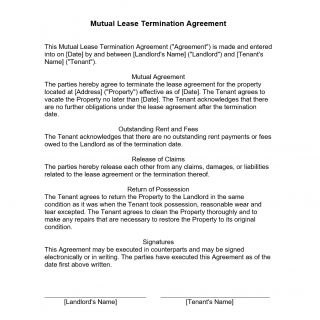Mutual Lease Termination Agreement
A Mutual Lease Termination Agreement is a legal document that allows both the landlord and the tenant to terminate their lease agreement before the agreed-upon end date, without any penalty or legal repercussions. This form is a mutual agreement between the parties involved, and it outlines the terms and conditions of the termination.
This form consists of several parts, including:
- Introduction: This section includes the names of the parties involved in the lease agreement, the date of the agreement, and a brief statement indicating the purpose of the agreement.
- Mutual Agreement: This section outlines the terms and conditions of the mutual lease termination, including the date of the termination, the amount of any outstanding rent or fees owed, and any other relevant details.
- Release of Claims: This section states that both parties agree to release each other from any claims, damages, or liabilities related to the lease agreement.
- Return of Possession: This section outlines the process for returning the property to the landlord, including any required cleaning or repairs.
- Signatures: This section includes a space for both parties to sign and date the agreement.
Some of the important fields to consider when compiling a Mutual Lease Termination Agreement include the date of the termination, the amount of any outstanding rent or fees owed, and the condition of the property at the time of termination.
Examples of when to use a Mutual Lease Termination Agreement include situations where the tenant needs to move out early due to a job transfer or other unforeseen circumstances, or where the landlord needs to sell the property and needs the tenant to vacate early.
The parties involved in a Mutual Lease Termination Agreement are the landlord and the tenant.
Benefits of using this form include avoiding legal disputes and penalties, and allowing both parties to move on without any further obligations or liabilities.
Risks of using this form include the possibility of disagreements over the amount of outstanding rent or fees owed, or disputes over the condition of the property at the time of termination.
Some related and alternative forms include Early Lease Termination Letter, Notice of Termination of Lease Agreement, and Termination of Lease Agreement.
Analogues of this form include Mutual Rescission of Lease Agreement and Agreement to Terminate Lease.
The main difference between a Mutual Lease Termination Agreement and other termination forms is that it is a mutual agreement between both parties, whereas other forms may be initiated by one party or the other.
This form influences the future of the participants by releasing them from any claims, damages, or liabilities related to the lease agreement, and allowing them to move on without any further obligations or legal disputes.
Once the form is signed by both parties, it should be submitted to the appropriate authorities, such as the landlord or property management company. Both parties should keep a copy of the agreement for their records.

